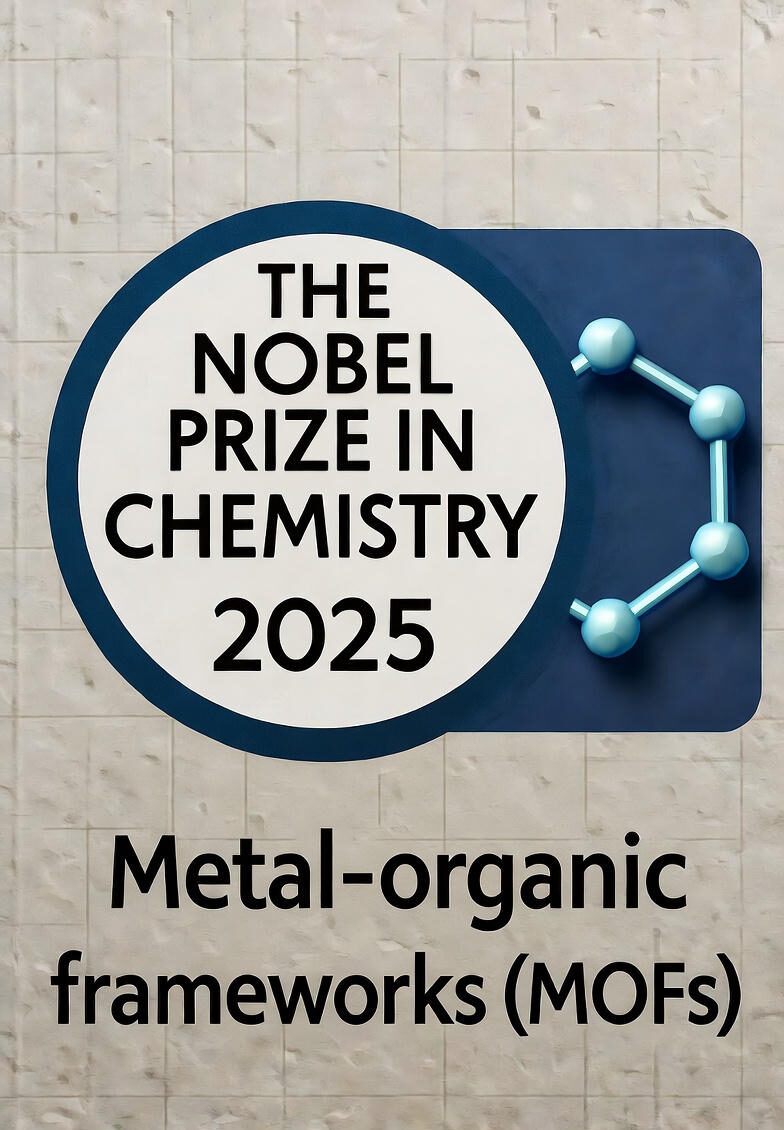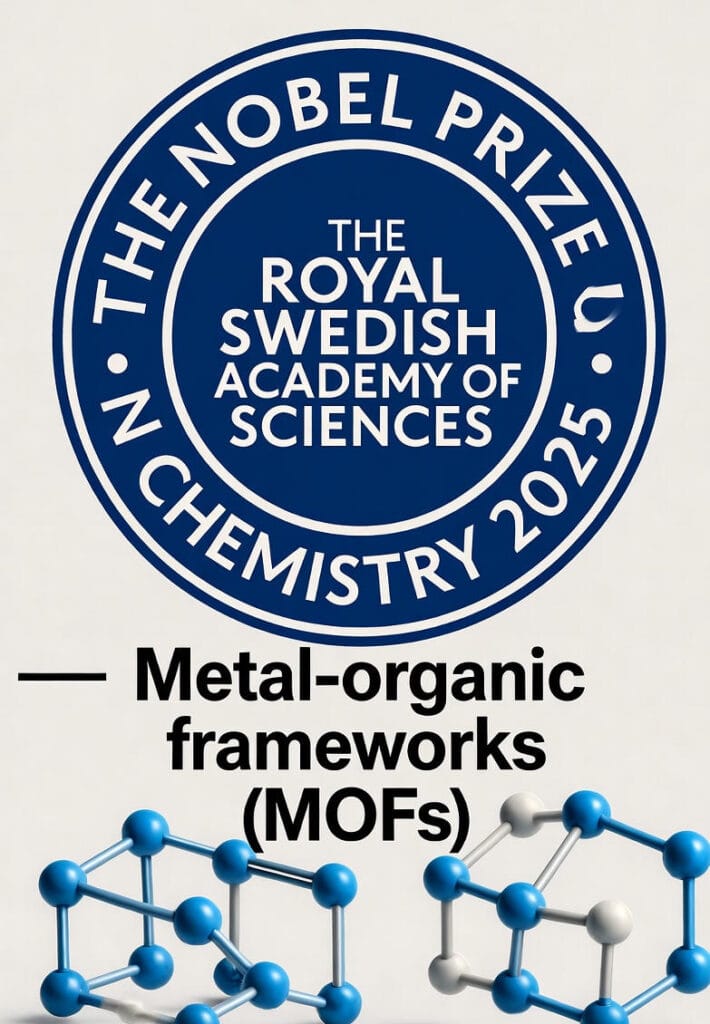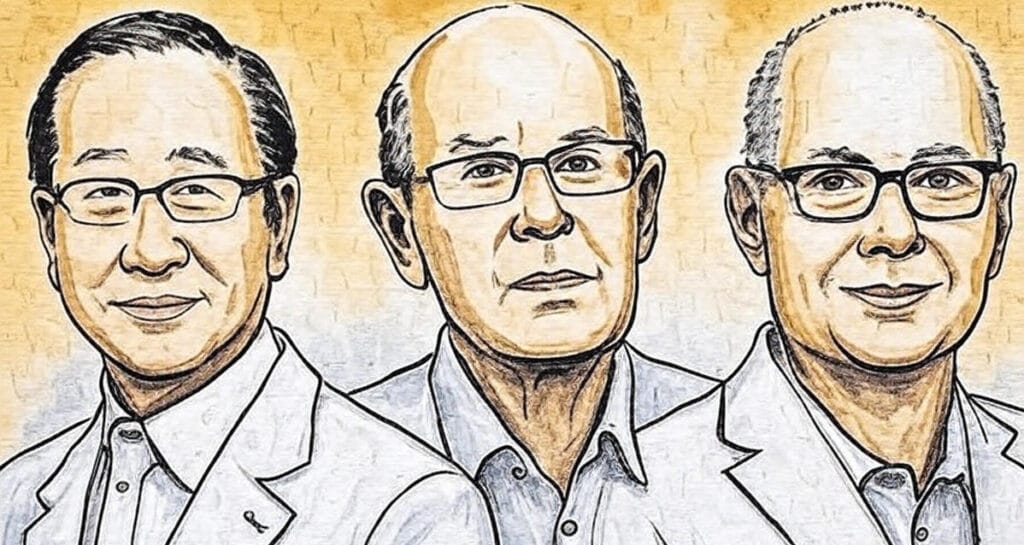
The 2025 Nobel Prize in Chemistry has been awarded to Susumu Kitagawa, Richard Robson, and Omar M. Yaghi for their groundbreaking work on MOFs. Announced by the Royal Swedish Academy of Sciences, this prestigious recognition celebrates their contributions to developing materials that address critical global challenges in energy storage, gas capture, and environmental sustainability. This blog explores the significance of their work, the science behind MOFs, and their transformative potential for a sustainable future.
Understanding Metal-Organic Frameworks (MOFs)
What Are MOFs?
Metal-organic frameworks are a class of porous materials composed of metal ions or clusters linked by organic molecules, forming highly ordered, crystalline structures. These materials are celebrated for their exceptional surface area and tunable properties, making them versatile for a range of applications.
- High Porosity: MOFs have some of the highest surface areas of any known materials, with a single gram offering surface areas equivalent to a football field.
- Customizable Structures: Their chemical composition can be tailored for specific tasks, such as capturing gases or catalyzing reactions.
- Sustainable Applications: MOFs are pivotal in addressing environmental and energy challenges, from carbon capture to clean energy storage.
Why MOFs Matter
The work of Kitagawa, Robson, and Yaghi has revolutionized materials science by unlocking MOFs’ potential to solve pressing global issues. Their discoveries enable innovations in industries ranging from energy to healthcare, offering sustainable solutions in an era of climate urgency.
The 2025 Nobel Laureates

Innovating Flexible Frameworks
Susumu Kitagawa, a Japanese chemist, is renowned for developing dynamic MOFs that adapt their structure in response to external stimuli, such as temperature or pressure. His pioneering research at Kyoto University has expanded the practical applications of MOFs, particularly in gas storage and separation.
Laying the Foundation
Australian chemist Richard Robson is credited with early theoretical and experimental work on MOFs. His research at the University of Melbourne established the conceptual framework for these materials, demonstrating their potential as highly organized, porous structures.
A Visionary in Reticular Chemistry
Omar M. Yaghi, based at the University of California, Berkeley, coined the term “reticular chemistry” to describe the design of MOFs and related materials. His work has led to thousands of new MOF structures, with applications in clean energy, water harvesting, and carbon dioxide capture.
Impact of MOFs on Global Challenges
Energy Storage and Conversion
MOFs are transforming energy storage by enabling more efficient hydrogen and methane storage systems. Their porous structures can store large volumes of gas at lower pressures, making them ideal for clean energy applications.
- Hydrogen Fuel Cells: MOFs enhance the efficiency of hydrogen storage, a key component of next-generation fuel cell vehicles.
- Battery Technologies: Their tunable properties improve battery performance, supporting renewable energy integration.
Environmental Sustainability
MOFs play a critical role in mitigating climate change. Their ability to selectively capture gases like carbon dioxide makes them a cornerstone of carbon capture and storage (CCS) technologies.
- Carbon Capture: MOFs can trap CO2 from industrial emissions, reducing greenhouse gas outputs.
- Water Purification: Certain MOFs can remove contaminants from water, addressing global water scarcity.
Healthcare and Beyond
Beyond energy and environment, MOFs show promise in drug delivery and medical diagnostics. Their ability to encapsulate and release molecules with precision opens new frontiers in personalized medicine.
Why the Nobel Prize Matters

The 2025 Nobel Prize in Chemistry underscores the importance of fundamental research in driving technological innovation. By honoring Kitagawa, Robson, and Yaghi, the Royal Swedish Academy of Sciences highlights the role of interdisciplinary science in tackling global challenges. Their work exemplifies how chemistry can lead to sustainable solutions that benefit humanity.
A Legacy of Collaboration
The trio’s collaborative efforts have inspired a global community of researchers. Their discoveries have led to over 70,000 MOF structures being documented, each with unique properties tailored to specific needs. This collaborative spirit continues to drive advancements in materials science.
The Future of MOFs
The recognition of MOFs in the 2025 Nobel Prize signals a bright future for these materials. Ongoing research is expanding their applications, from industrial catalysis to advanced sensors. As governments and industries prioritize sustainability, MOFs are poised to play a central role in achieving net-zero goals.
Challenges and Opportunities
While MOFs hold immense potential, challenges remain in scaling their production for commercial use. Researchers are working to make MOF synthesis more cost-effective and environmentally friendly. Advances in automation and artificial intelligence are accelerating the discovery of new MOFs, ensuring their widespread adoption.
Conclusion
The 2025 Nobel Prize in Chemistry awarded to Susumu Kitagawa, Richard Robson, and Omar M. Yaghi celebrates their transformative contributions to metal-organic frameworks. Their work has redefined materials science, offering innovative solutions to energy, environmental, and healthcare challenges. As MOFs continue to evolve, their impact on sustainability and technology will shape a brighter, greener future. Stay tuned to the latest in chemistry and innovation to see how these remarkable materials change the world.







